In today’s fast-paced and digitally-driven world, teaching children the art of mindfulness has become increasingly important. Mindfulness games for kids are innovative tools designed to introduce children to the concept of mindfulness through play and interactive activities. These games combine elements of fun, creativity, and self-awareness to help kids develop skills for managing stress, improving focus, and cultivating emotional well-being.
Mindfulness games for kids provide a structured and engaging way for children to explore their inner world and develop a greater sense of self-awareness. By incorporating mindfulness principles into games, children learn to pay attention to the present moment, without judgment, and cultivate a deeper understanding of their thoughts, emotions, and sensations.
The benefits of mindfulness games for kids are numerous and far-reaching. Firstly, they help children develop crucial skills in emotional regulation and self-control. By learning to observe their thoughts and emotions without immediately reacting, children gain a sense of inner calm and learn healthier ways to respond to challenging situations.
Secondly, mindfulness games for kids enhance children’s focus and attention span. By engaging in activities that require presence and concentration, kids learn to direct their attention intentionally and improve their ability to concentrate on tasks at hand.
Mindfulness games for kids also promote social and emotional skills. They teach children empathy, compassion, and kindness by encouraging them to consider the feelings and perspectives of others. Through cooperative gameplay and group activities, children learn to communicate effectively, collaborate, and develop healthy relationships.
Table of contents
Game 1: Mindful Scavenger Hunt
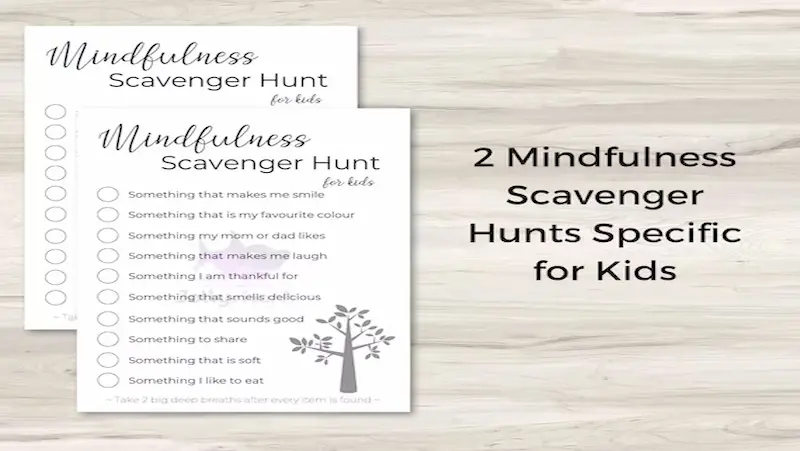
Instructions for Organizing a Mindful Scavenger Hunt:
Choose a suitable location: Select a safe and accessible outdoor area such as a park, garden, or nature reserve. Alternatively, you can conduct the scavenger hunt indoors using objects and elements found within the house.
Define the rules and objectives: Explain the purpose of the mindful scavenger hunt to the children. Emphasize the importance of being present, observing their surroundings, and engaging their senses.
Create a list of items or qualities: Prepare a list of items or qualities for the children to find during the scavenger hunt. These can be tangible objects like leaves, rocks, or flowers, or intangible qualities like serenity, joy, or beauty. Ensure the list aligns with the age group and the environment.
Provide mindfulness guidance: Before the scavenger hunt begins, take a few moments to guide the children in a brief mindfulness exercise. Encourage them to focus on their breath, bring their attention to the present moment, and set an intention to be aware and observant throughout the activity.
Distribute the lists and begin the hunt: Hand out the scavenger hunt lists to each child or divide them into teams if playing in a group. Explain any specific instructions, time limits, or boundaries if necessary. Encourage children to explore mindfully and remind them to exercise caution and respect for their surroundings.
Items or Qualities to Look for During the Hunt:
Natural objects: Leaves, flowers, rocks, feathers, pinecones, shells, or tree bark.
Animal signs: Footprints, nests, burrows, or feathers.
Sights and sounds: Colors, patterns, textures, different types of birdsong, rustling leaves, or running water.
Natural phenomena: Cloud formations, sunsets, rainbows, or spider webs.
Sensations: Warmth from the sun, cool breeze, the feeling of grass or sand beneath their feet, or the sound of their own breath.
Tips for Encouraging Presence and Awareness:
Encourage silence: Encourage children to explore in silence, allowing them to focus on their observations and the present moment without distractions.
Engage the senses: Encourage children to engage all their senses during the scavenger hunt. Prompt them to touch, smell, listen, and observe keenly to deepen their connection with the environment.
Practice gratitude: After each item or quality is found, take a moment to reflect and express gratitude for the discovery. Encourage children to share their experiences with the group if playing in a team.
Foster curiosity: Encourage children to ask questions, investigate, and explore further if something captures their interest. Nurture their curiosity and guide them to investigate the details of their findings.
Reflect and share experiences: At the end of the scavenger hunt, gather the children together for a brief reflection. Ask them to share their favorite discoveries, their feelings during the activity, and any insights they gained about themselves or their environment.
Game 2: Sensory Exploration
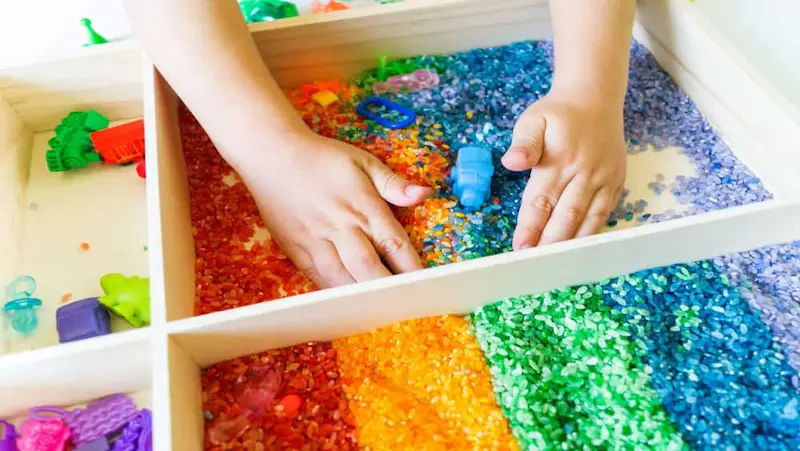
In today’s fast-paced world, finding moments of stillness and mindfulness can be challenging. However, there are various activities that can help us reconnect with the present moment and foster a sense of calm and awareness.
One such approach is sensory exploration, which involves engaging our senses intentionally. In this blog, we will delve into the realm of sensory activities that promote mindfulness, such as sensory walks, texture exploration, and blindfolded games. We will also explore the incredible benefits of engaging our senses for mindfulness.
Sensory Walks:
Sensory walks are a delightful way to engage with the world around us and heighten our awareness of the present moment. Instead of rushing through your daily walk, take the opportunity to slow down and pay attention to the sensory details. Notice the feel of the ground beneath your feet, the scent of the flowers in bloom, the sounds of birds chirping, and the colors that surround you. Allow each sensation to anchor you in the present and cultivate a deeper connection with your environment.
Texture Exploration:
Engaging with different textures can be an incredibly grounding and meditative experience. Set aside some time to explore various textures in your environment. This can be done by touching different surfaces like the bark of a tree, a smooth pebble, or the soft petals of a flower. Pay attention to the tactile sensations, focusing on the pressure, temperature, and texture against your skin. This simple activity can bring you into the present moment and create a sense of tranquility.
Blindfolded Games:
Blindfolded games can be a unique and exciting way to explore mindfulness through sensory deprivation. By temporarily blocking our sight, we can enhance our other senses and deepen our connection to the present moment. Engage in simple blindfolded games such as taste tests, where you try to identify different flavors without the aid of sight or have a friend guide you through a room or a natural environment while blindfolded. These activities not only promote mindfulness but also foster trust, communication, and an appreciation for our senses.
Check Out These Mind-Blowing Online Games for Kids – Unleash the Excitement and Adventure Right at Your Fingertips
Benefits of Engaging the Senses for Mindfulness:
a. Heightened Awareness: Engaging our senses intentionally helps us become more attuned to the present moment. By focusing on sensory experiences, we shift our attention away from the past or future, cultivating a state of mindfulness.
b. Stress Reduction: Sensory exploration can serve as a powerful stress management tool. When we immerse ourselves in sensory activities, it allows us to temporarily detach from our worries and anxieties, promoting relaxation and reducing stress levels.
`Empowering Young Minds with Effective Stress Management for Kids Nurturing Emotional Resilience and Equipping Them with Essential Life Skills to Thrive in Challenging Situations
c. Improved Focus and Concentration: Training our senses through mindfulness activities enhances our ability to concentrate. By sharpening our sensory awareness, we develop a greater capacity to focus on tasks and stay present.
d. Heightened Enjoyment of Everyday Experiences: Engaging our senses mindfully opens the door to a world of vivid experiences. We begin to appreciate the beauty and richness of even the simplest things, fostering a sense of gratitude and joy in our daily lives.
Game 3: Yoga Adventure
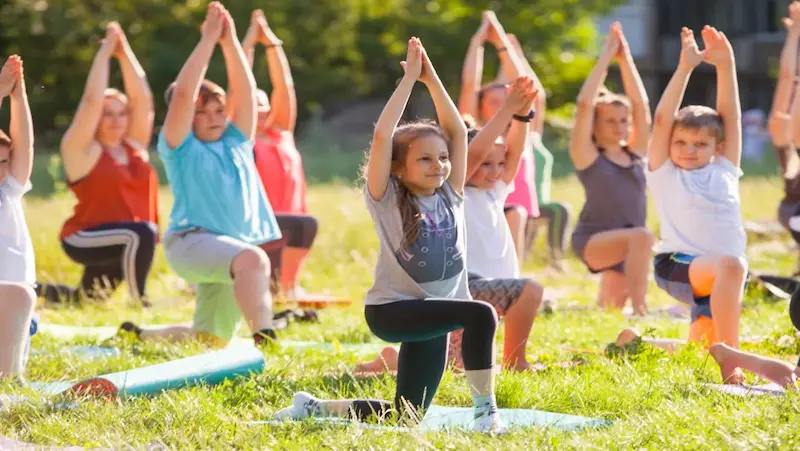
Mindful Movement: Exploring Yoga for Kids
Yoga is not only for adults; it can also be an excellent practice for children. Yoga provides numerous benefits, including increased flexibility, improved strength, and balance, better focus and concentration, and reduced stress and anxiety. Moreover, it cultivates a sense of body awareness and teaches children to be present at the moment.
When introducing yoga to kids, it’s essential to make it enjoyable and relatable to their interests. This is where Game 3: Yoga Adventure comes in. By turning yoga into an interactive and imaginative journey, children are more likely to embrace the practice and experience its many benefits. Guiding Little Minds: Discover the Transformative Benefits of Mindfulness Meditation for Kids Fostering Calm and Emotional Well-being.
Kid-Friendly Yoga Poses: A Sequence for Adventure
Mountain Pose (Tadasana): Stand tall with feet hip-width apart, arms at the sides, and palms facing forward. Imagine standing at the base of a majestic mountain, feeling strong and grounded.
Tree Pose (Vrksasana): Shift weight onto one leg, bend the other knee, and place the sole of the foot on the inner thigh or calf. Extend arms overhead like branches swaying in the wind. Imagine being a tree in a beautiful forest, reaching toward the sky.
Downward-Facing Dog (Adho Mukha Svanasana): Start on all fours, then lift your hips up, straightening your legs and arms. Form an inverted “V” shape with your body. Imagine being a playful dog stretching and waking up in the morning.
Butterfly Pose (Baddha Konasana): Sit on the floor, bend your knees, and bring the soles of the feet together. Hold onto the feet and gently flap the knees up and down. Imagine being a colorful butterfly fluttering its wings.
Cobra Pose (Bhujangasana): Lie on your stomach, place your palms beside your shoulders, and lift your chest while keeping your pelvis grounded. Imagine being a strong cobra gracefully rising up from the ground.
Incorporating Storytelling and Imagination:
To transform the yoga adventure into an immersive experience, storytelling, and imagination play a vital role. Here’s how to incorporate these elements:
Choose a theme: Select a theme for the yoga adventure, such as exploring the jungle, diving into the ocean, or traveling to outer space. The chosen theme will guide the storytelling aspect and the poses incorporated.
Narrate the journey: As children move through each yoga pose, narrate a story that corresponds to the theme. Encourage them to visualize the surroundings and characters in their minds. For example, during the jungle adventure, they can encounter animals like lions, monkeys, and elephants.
Encourage creativity: Allow children to use their imagination to create their own stories and characters during the yoga adventure. This empowers them to express themselves and make the experience uniquely their own.
Use props and visuals: Incorporate props or visuals related to the theme to enhance the storytelling experience. For example, for an underwater adventure, use blue fabrics or imagery of fish and coral reefs.
Game 4: Mindful Art and Crafts

The Therapeutic Effects of Artistic Expression on Mindfulness
Artistic expression has long been recognized as a powerful medium for self-expression and emotional release. Engaging in art and crafts can have a profound impact on our mental, emotional, and even physical well-being. Here are a few ways in which artistic expression promotes mindfulness:
Stress Reduction: Creating art allows us to enter a state of flow, where we become fully immersed in the present moment. This immersion helps reduce stress and anxiety by redirecting our focus away from negative thoughts or worries.
Self-Exploration: Through art, we can explore our inner thoughts, emotions, and experiences in a non-judgmental and safe environment. This process of self-exploration can lead to increased self-awareness and personal growth.
Mindful Observation: Art encourages us to observe our surroundings more mindfully, paying attention to details, textures, and colors. This heightened awareness of the present moment cultivates mindfulness in our everyday lives.
Emotional Healing: Art provides a channel for expressing and processing difficult emotions. By externalizing our feelings through artistic expression, we can experience emotional release and find solace in the process.
Mindful Art Activities
Mandala Drawing: Mandala drawing is a popular mindful art activity that involves creating intricate geometric patterns within a circular shape. Start by drawing a circle, then use various shapes, lines, and colors to create your unique mandala design. As you focus on the intricate details, you’ll enter a state of mindfulness.
Nature-Inspired Crafts: Engaging with nature can be a deeply grounding and calming experience. Incorporate nature into your mindful art activities by collecting leaves, flowers, or pebbles to create nature-inspired crafts. Use these natural elements to make collages, pressed flower art, or even rock painting.
Zen Tangle: Zen tangle is a form of structured doodling that promotes relaxation and focus. To create a Zen tangle, start with a small square or rectangle and divide it into sections. Then, fill each section with intricate patterns or repetitive strokes. Allow yourself to get lost in the rhythm and flow of the lines.
Unleash Creativity: Explore Mind-Blowing Crafts for Kids That Spark Imagination and Delight in Every Creation.
Step-by-Step Mindful Art Project: DIY Gratitude Journal
A gratitude journal is a wonderful mindful art project that encourages reflection, positivity, and gratitude. Follow these step-by-step instructions to create your own gratitude journal:
Materials needed:
1. Notebook or journal
2. Decorative paper or fabric
3. Scissors
4. Glue or double-sided tape
5. Markers, pens, or colored pencils
6. Optional: stickers, washi tape, or any other decorative elements
Instructions:
1. Select a notebook or journal that resonates with you. It could be a plain notebook that you can decorate or a journal with blank pages.
2. Cut a piece of decorative paper or fabric slightly larger than the size of the front cover of your notebook.
3. Use glue or double-sided tape to affix the decorative paper or fabric to the front cover, ensuring a smooth and neat finish.
4. Personalize your gratitude journal by adding your name, inspiring quotes, or any other embellishments using markers, pens, or colored pencils.
5. Create sections within your journal for different aspects of gratitude, such as relationships, achievements, nature, or daily blessings.
6. Each day, take a few moments to reflect on what you’re grateful for and write it down in your journal. You can also include small sketches or doodles related to your gratitude.
7. Set a regular time for journaling, such as before bed or during your morning routine, to cultivate a consistent gratitude practice.
Game 5: Mindful Listening
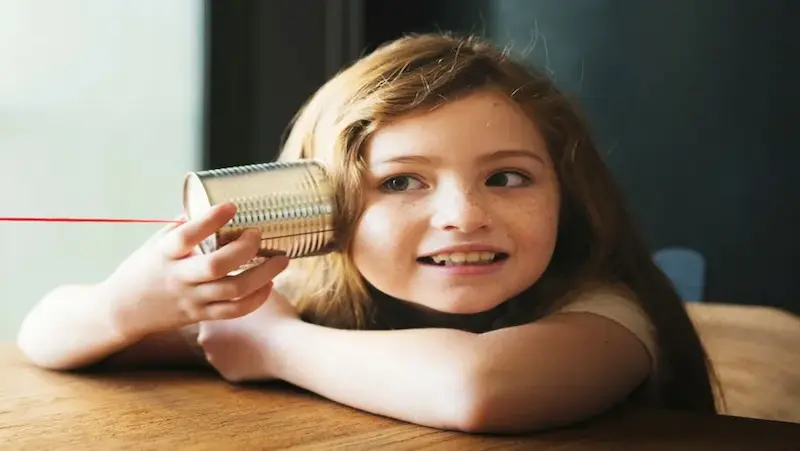
The Importance of Attentive Listening for Mindfulness
Attentive listening is an essential component of mindfulness as it encourages individuals to be fully present and engaged with their surroundings. When we consciously listen to sounds, we redirect our attention from the constant chatter in our minds and immerse ourselves in the present moment. Mindful listening allows us to deepen our understanding of the environment, notice subtle details, and appreciate the beauty of the world around us. Moreover, by focusing on sounds, we can practice non-judgmental awareness, accepting the sounds as they are without attaching any labels or interpretations.
Listening to Games and Activities for Children
Sound Scavenger Hunt: Create a list of specific sounds for children to identify and locate within their environment. For example, the rustling of leaves, the chirping of birds, the ticking of a clock, or the sound of running water. Encourage children to actively listen and mark off the sounds they hear. This game not only enhances their ability to focus but also heightens their observation skills.
Guided Listening Meditations: Guided meditations can be a wonderful way to introduce children to mindful listening. Find recordings or use your own voice to guide children through a meditation where they focus on different sounds, such as the sound of their breath, the ambient noises around them, or even soothing nature sounds. These meditations help children attune their attention to the present moment and deepen their sensory awareness.
Sound Concentration Game: Play a variation of the classic concentration game using sounds instead of cards. Gather a variety of sound recordings or objects that produce distinct sounds and place them face down. Each player takes turns flipping two items and tries to match the sounds. This game promotes auditory discrimination and challenges children to listen attentively.
Sound Storytelling: Encourage children to create stories based on the sounds they hear. Provide them with a variety of soundscapes or play sounds from nature, musical instruments, or everyday objects. Children can take turns listening to a sound and then contribute to a group story, incorporating the sound they heard. This activity fosters creativity, imagination, and attentive listening.
Game 6: Breathing and Meditation Exercises
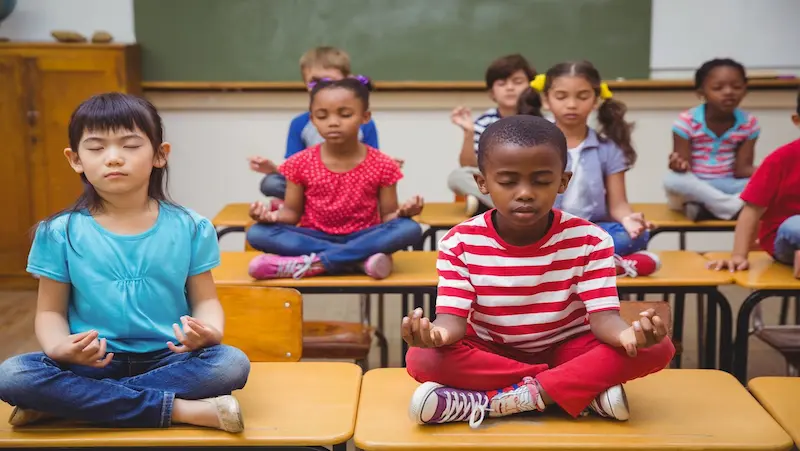
The Power of Mindful Breathing:
Mindful breathing serves as a valuable tool for children to anchor themselves in the present moment, enabling them to better manage their emotions and reduce stress. By focusing their attention on their breath, children develop self-awareness and learn to let go of distracting thoughts. The simplicity of these exercises makes them accessible to kids of all ages.
Simple Breathing Exercises for Kids:
a) Balloon Breath: Encourage children to imagine their bellies as a balloon. As they inhale through their nose, have them visualize inflating the balloon, filling it with air. Then, as they exhale through their mouth, instruct them to imagine the balloon deflating. Repeat this exercise several times, emphasizing the importance of slow and steady breaths.
b) Bee Breath: This exercise involves buzzing like a bee during exhalation. Ask children to take a deep breath through their noses and exhale slowly while producing a buzzing sound. This practice helps children focus on their breath while engaging in playful vocalization.
c) Square Breath: Guide children to imagine a square and visualize tracing its edges with their breath. Inhale while tracing the first side of the square, hold your breath while tracing the second side, exhale while tracing the third side, and finally, hold your breath again while tracing the fourth side. This exercise helps children develop concentration and a sense of rhythmic breathing.
Benefits of Mindful Breathing:
a) Calming Effect: Mindful breathing has a profound calming effect on children’s minds and bodies. It reduces anxiety, and stress, and helps them find a sense of inner peace even in challenging situations.
b) Increased Self-Awareness: Regular practice of mindful breathing enhances children’s ability to recognize their emotions and respond to them in a more thoughtful and controlled manner. It cultivates empathy and emotional intelligence.
c) Improved Focus and Concentration: By training their attention to remain on the breath, children develop stronger focus and concentration skills, which can positively impact their academic performance and overall productivity.
Guided Meditation Scripts and Apps:
a) Guided Meditation Scripts: Encourage children to close their eyes and visualize peaceful scenes, such as a calm beach or a serene forest. You can find various guided meditation scripts online that cater specifically to kids, allowing them to explore their imagination while fostering relaxation.
b) Meditation Apps for Kids: Several meditation apps offer age-appropriate mindfulness exercises and guided meditations designed for children. Some popular options include “Headspace for Kids,” “Calm Kids,” and “Smiling Mind.” These apps provide engaging visuals, gentle narration, and interactive features to make the experience enjoyable for kids.
Conclusion
In conclusion, screen-free mindfulness games for kids have emerged as a valuable and essential tool in our increasingly digitized world. These games offer a refreshing alternative to the constant stimulation and overexposure to screens that characterize modern life.
By encouraging individuals to unplug, engage with their surroundings, and connect with their inner selves, screen-free mindfulness games for kids promote mental well-being, focus, and self-awareness.
The importance of screen-free mindfulness games for kids lies in their ability to counteract the negative effects of excessive screen time. With the rise of technology, people are spending more hours in front of screens, leading to heightened stress levels, decreased attention spans, and a disconnection from the present moment.
By providing an offline and immersive experience, these games offer a respite from the digital overload and enable individuals to cultivate a greater sense of mindfulness and balance in their lives.
In a world where screens dominate our attention, screen-free mindfulness games for kids provide a necessary antidote. They remind us to slow down, be present, and engage with the world around us in a more mindful and intentional way.
Also, BrightChamps provides a comprehensive platform for learning about money for kids, offering interactive and engaging resources that teach financial literacy, budgeting, saving, and other essential money management skills. Learn about coding for kids too.
Frequently Asked Questions
A1. Some screen-free mindfulness games for kids indoors include puzzle solving, board games like chess or Scrabble, and sensory activities like playing with kinetic sand or coloring mandalas.
A2. Encourage your child to engage in screen-free fun by setting aside dedicated time for activities like arts and crafts, nature walks, reading books together, and introducing them to meditation or breathing exercises.
Ready for Fun? Explore Exciting Games for Kids to Play Just Dive In and Let the Adventures Begin.
A3. Outdoor games that promote mindfulness and don’t require screens include nature scavenger hunts, yoga in the park, mindful walking or hiking, and playing with bubbles or flying a kite.
A4. The benefits of screen-free fun and mindfulness games for kids include improved focus, reduced stress, enhanced creativity, better social interaction, and increased awareness of their emotions and surroundings.
A5. Simple mindfulness activities for car rides or travel include playing “I Spy,” listening to calming music or guided meditations, engaging in storytelling or imagination games, and practicing deep breathing exercises.
A6. Incorporate mindfulness games into your child’s daily routine by allocating specific time slots for activities like mindfulness coloring, journaling, practicing gratitude, or doing yoga together.
A7. Family mindfulness games can include group meditation or breathing exercises, creating a gratitude jar or collage, taking nature walks together, and playing cooperative board games that encourage communication and teamwork.
A8. Creative and artistic screen-free activities that promote mindfulness in children include painting or drawing, making crafts with recycled materials, sculpting with clay, and learning to play a musical instrument.
A9. Screen-free games that improve focus and concentration in kids include memory matching games, puzzles of varying difficulty levels, building blocks or Legos, and activities like origami or tangrams.
A10. Strike a balance between screen time and screen-free fun for your child by setting clear limits on screen usage, establishing tech-free zones or times, providing alternative activities, and being a positive role model by engaging in screen-free activities yourself.


 We are an army of educators and passionate learners from BrightChamps family, committed to providing free learning resources to kids, parents & students.
We are an army of educators and passionate learners from BrightChamps family, committed to providing free learning resources to kids, parents & students.







